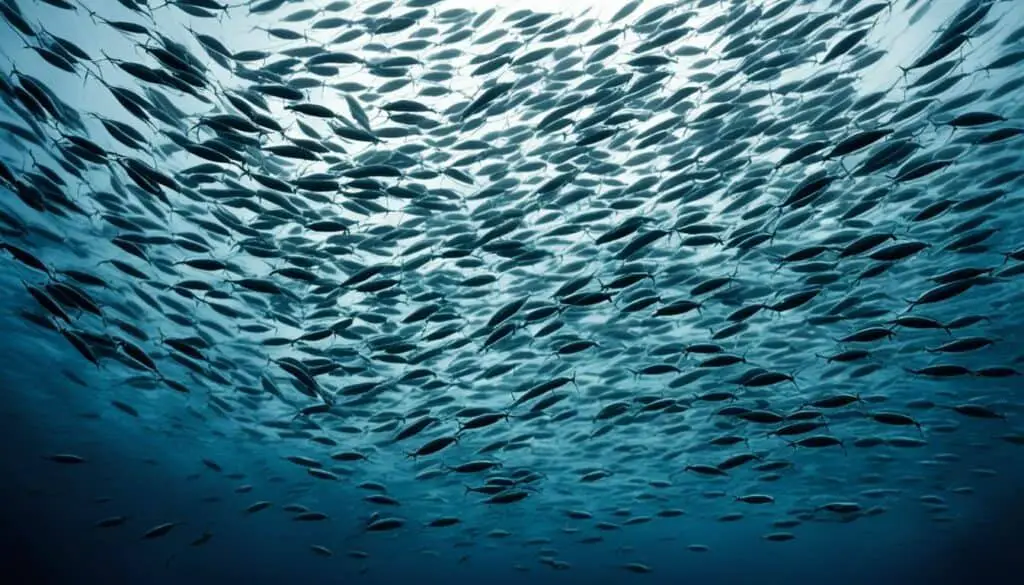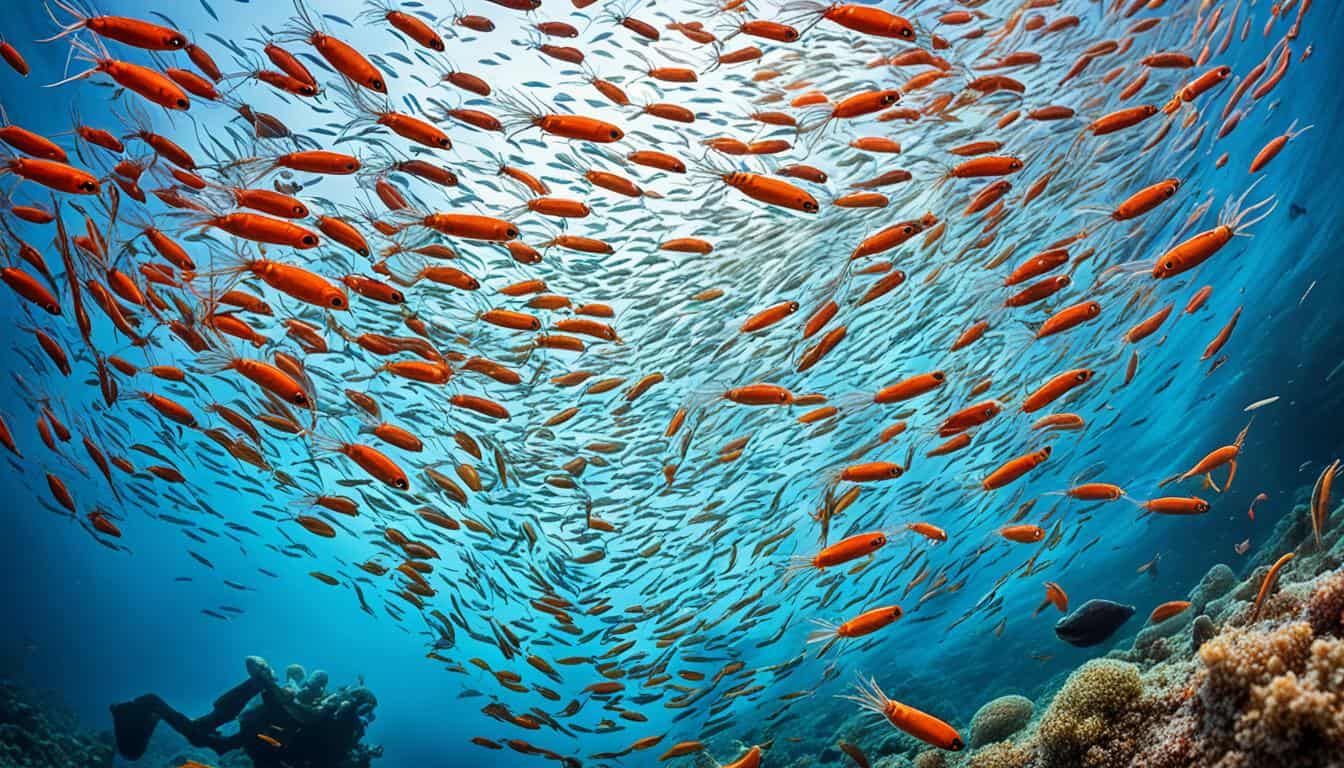Are krill endangered? This question is becoming more important as we learn how vital these small crustaceans are to our oceans. Krill live mainly in the Southern Ocean and have a huge population of 300 million to 500 million metric tons. Even though they’re not endangered yet, their conservation status is worrying because of many threats.
Overfishing, climate change, pollution, and losing their habitat are all dangers to krill and the ocean’s balance. As people want more krill for food and supplements, we need to act fast to protect them. This is crucial for the health of our oceans and the life that depends on them.
The Importance of Krill in the Marine Ecosystem
Krill play a key role in marine ecosystems. They keep the food chain stable and support many marine species. This helps create a healthy marine environment.
Role in the Food Chain
Krill are crucial in the food chain. They feed many larger species like whales, seals, fish, and seabirds. This shows how vital krill are for survival.
Krill also act as filter feeders. They eat phytoplankton, which absorbs carbon dioxide. This helps fight climate change and keeps marine life in balance.
Impact on Marine Biodiversity
Krill diversity is key to ocean health. They support many marine species and habitats. This ensures energy and nutrients move well through the ecosystem.
Many species rely on krill for food. So, a drop in krill numbers can harm marine life. This could lead to a big impact on the ocean’s balance.
| Key Roles of Krill | Impacted Species | Consequences of Decline |
|---|---|---|
| Filter Feeding | Whales, Seals | Reduced predator populations |
| Carbon Sequestration | Fish, Seabirds | Increased CO2 levels |
| Nutrient Cycling | Various marine species | Disruption of food web |
Understanding Krill Population Dynamics
Krill populations are key to understanding the marine ecosystem’s health. Their numbers affect biodiversity greatly. The current estimates of krill biomass show around 400 million metric tons. This means over 700 trillion adult krill live in the Southern Ocean.
Current Estimates of Krill Biomass
Krill live in about 32 million square kilometers of ocean. This space is crucial for their growth and supports many other sea creatures. But, there are worrying signs of a decline in krill numbers. Places like Area 48 at the Antarctic Peninsula are at risk due to overfishing, leading to local krill shortages.
Population Distribution Across the Southern Ocean
Krill are found in different parts of the Southern Ocean, but not everywhere. Knowing where they live is important for the health of marine life. Studies show that some areas where krill used to be plentiful are now much emptier. This is due to fishing and climate change effects.

Are krill endangered?
The current krill conservation status shows a complex situation. Krill are not endangered on their own, but they face many threats. The Commission for the Conservation of Antarctic Marine Living Resources (CCAMLR) works to manage krill fishing sustainably. However, threats like overfishing and climate change are harming the marine ecosystem.
Conservation Status Overview
Krill are watched closely because they are key to the marine food web. The CCAMLR sets rules to keep them safe. But, worries about krill numbers are growing. Overfishing and the rise in demand for krill products are big risks. Climate change also affects krill by changing their home in the ocean.
Comparison with Other Marine Species
Krill face similar challenges as other marine species. Many are at risk of disappearing because of humans. Here’s how krill compare with other marine animals:
| Species | Current Status | Main Threats |
|---|---|---|
| Krill | Not Endangered | Overfishing, Climate Change |
| Humpback Whale | Least Concern | Ship Strikes, Habitat Loss |
| Pacific Bluefin Tuna | Critically Endangered | Overfishing, Illegal Fishing |
| Sea Lions | Endangered | Climate Change, Pollution |
| Coral Reefs | Vulnerable | Ocean Acidification, Temperature Rise |
This comparison shows how marine species are connected. It also stresses the need for action to protect krill. Keeping krill safe is crucial for the health of the ocean.
Factors Contributing to Krill Population Decline
The decline of krill populations worries marine biologists and conservationists a lot. Many important factors are causing these vital crustaceans to decrease in number. Knowing about these factors helps us see why we need to act fast to save krill and the marine ecosystem they support.
Overfishing and Unsustainable Practices
Overfishing is a big threat to krill, especially where they live in large groups. Even with fishing rules, these don’t always keep up with fast environmental changes. This includes warmer ocean temperatures and less sea ice, which are crucial for young krill. Bad fishing methods can empty out krill in certain areas, making things worse for krill and other species that depend on them.
Climate Change and Its Effects
Climate change makes things harder for krill with changing water temperatures and more ocean acidification. These changes hurt krill growth and breeding. As their home gets worse, pollution and habitat loss become bigger problems for krill. This shows we need strong conservation efforts to help krill survive. They are key to keeping marine life diverse and the oceans healthy.
FAQ
Are krill endangered?
Krill are not endangered yet, but their situation is worrying. They face threats like overfishing, climate change, and losing their homes.
Why are krill important in the marine ecosystem?
Krill are crucial to the ocean’s food chain. They feed many big species like whales and seals. They also help keep the ocean diverse and healthy.
What is the current estimate of krill biomass?
Scientists think there are about 400 million metric tons of Antarctic krill. This means over 700 trillion adult krill live in the Southern Ocean.
How is krill population distributed across the Southern Ocean?
Krill live in a huge area of the Southern Ocean, covering 32 million square kilometers. This space is key for their survival and for feeding other sea creatures.
What is the conservation status of krill?
Krill are not endangered, but they face threats that could lower their numbers. These threats are similar to those faced by other sea creatures due to human actions and environmental changes.
What are the primary threats to krill species?
Krill are threatened by overfishing, climate change, pollution, and losing their homes. These threats can cause their numbers to drop in specific areas and overall.
How does overfishing impact krill populations?
Overfishing, especially in krill-rich areas, can greatly reduce their numbers. This threatens the long-term health of their populations and the species that depend on them.
What effects does climate change have on krill?
Climate change affects krill by changing ocean temperatures, melting sea ice, and making the ocean more acidic. These changes are important for their life cycle.
What can be done to protect krill populations?
To protect krill, we need to use stronger conservation efforts. We should support sustainable krill fishing and protect their homes. This will help ensure they can thrive in the future.







